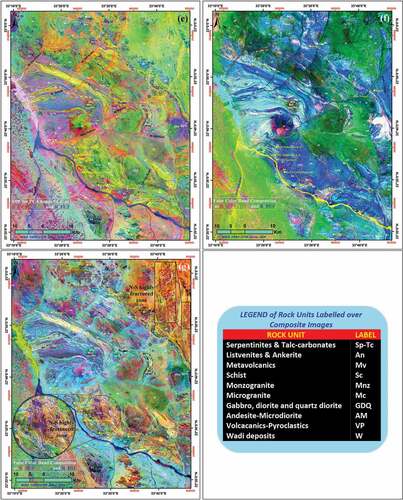Figures & data
Figure 1. (a) Location of the study area. (b) A simplified geological map of the Egyptian Eastern Desert highlights the general geology and position of the study area (modified after Ramadan et al. Citation2001; Abdelsalam et al. Citation2003; Abdelsalam Citation2010; Johnson et al. Citation2011, Citation2017; Azer Citation2013; ElGalladi et al. Citation2022). (c) Detailed geological map of west Allaqi-Heiani Suture (AHS) (Kusky and Ramadan Citation2002; ElGalladi et al. Citation2022).
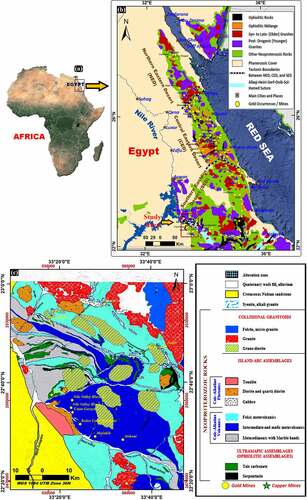
Figure 2. (a) Drainage system over west Allaqi district. (b) 3D view simulates the topography setting with the drainage network.
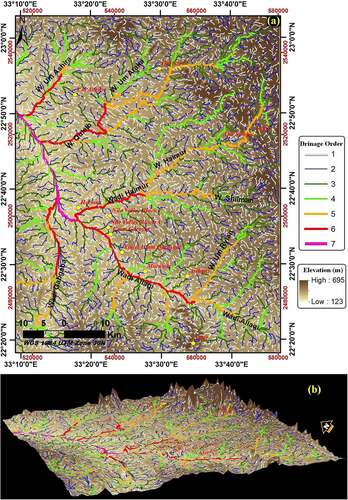
Figure 3. A flowchart scheme shows the processing techniques used for the exploration of new prospective mineralisation potential zones over the west Allaqi-Heiani Suture (AHS).

Table 1. Statistical factors used for estimating the band ratios threshold values for mapping alteration minerals in .
Figure 4. Threshold of band ratios 6/7, 6/5 and 4/2 to extract alteration zones: (a) Hydroxyl-bearing and carbonate minerals extraction, BR 6/7. (b) Extraction of ferrous-iron oxide minerals, BR 6/5. (c) Extraction of ferric-iron oxides minerals, BR 4/2. (d) The alteration minerals overlaid the natural colour image of Google Earth.
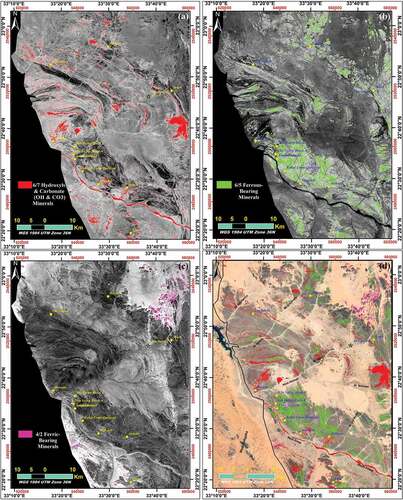
Table 2. PCA eigenvector matrix of Landsat 8 used bands (B1–B7).
Figure 5. (a) Extraction of hydroxyl-bearing and carbonate minerals by thresholding the inverted PC4. (b) Extraction of iron oxide minerals by thresholding the inverted PC5. (c) Extraction of hydroxides and iron oxides by thresholding the inverted (PC4+ PC5). (d) Crosta’s FCC image of inverted PC4, inverted (PC4+ PC5) and inverted PC5 as RGB.
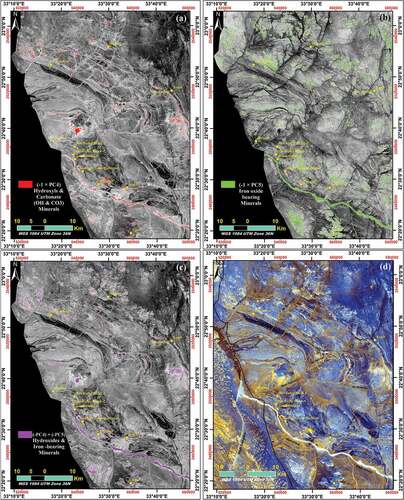
Figure 6. (a) Extraction of hydroxyl-bearing and carbonate minerals by thresholding MNF3. (b) Extraction of iron oxide minerals by thresholding MNF4. (c) Extraction of hydroxides and iron oxide minerals by thresholding MNF3 + MNF4 image. (d) Crosta alteration image, FCC image of MNF3, (MNF3+ MNF4) and MNF4 respectively as RGB.
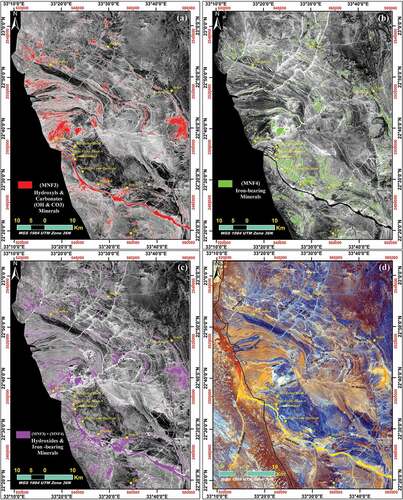
Table 3. Eigenvectors of MNF components of Landsat 8 used bands (B1-B7).
Figure 7. (a) Remotely sensed combination of lineaments extracted automatically from the composition of enhanced PC1, MNF1 and DEM images. (b) Remote sensed lineament density map of west AHS. (c) Lineaments orientation rose diagram. (d) Lineaments length rose diagram. (e) Basic statistics of the total automatically extracted lineaments.
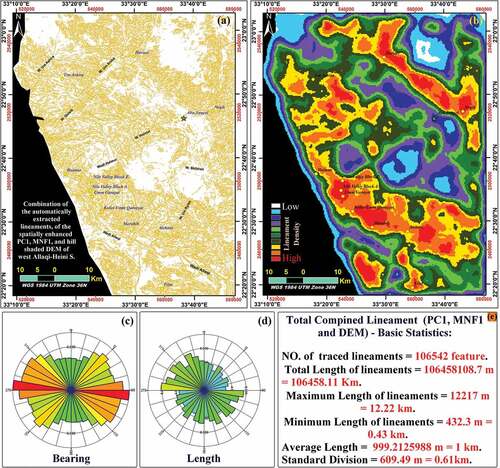
Figure 8. Automatically, remotely sensing, extracted lineaments for alteration zones: (a) Lineaments of hydroxyl-bearing zones. (b) Lineaments of iron-oxide altered zones. (c) Lineaments orientation rose diagram of hydroxyl-bearing zones. (d) Lineaments length rose of hydroxyl altered zones. (e) Lineaments trend rose diagram of iron-oxides. (f) Lineaments length rose diagram of iron-oxide altered zones.
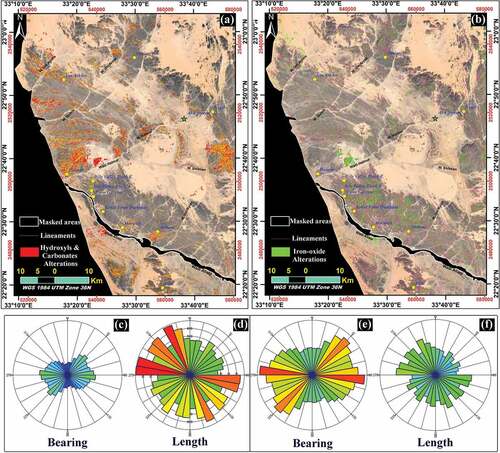
Figure 9. (a) RTP map. (b) Tilt derivative (TDR) map. (c) Zero contours of TDR map to outline the edges of magnetic anomalies, with their rose diagram. (d) Euler solutions estimated the depths to magnetic contacts at shallow depths (≤−150 m), with their rose diagram (ElGalladi et al. Citation2022).
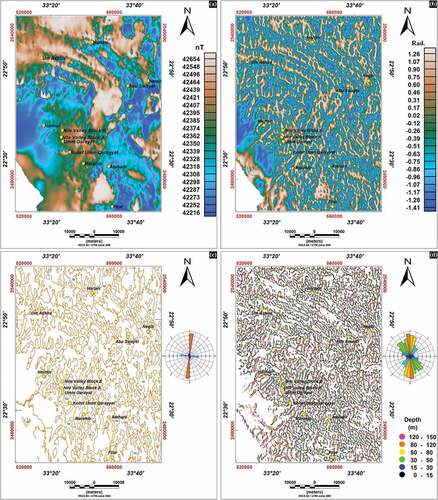
Figure 10. (a) Analytic signal map of the total magnetic field (AS). (b) Analytic signal of the first vertical derivative (AS1). (c) Depth estimations to the magnetic sources using the analytic signal technique. (d) Depth solutions to the magnetic sources/contacts, beneath AHS, using the SPI technique.
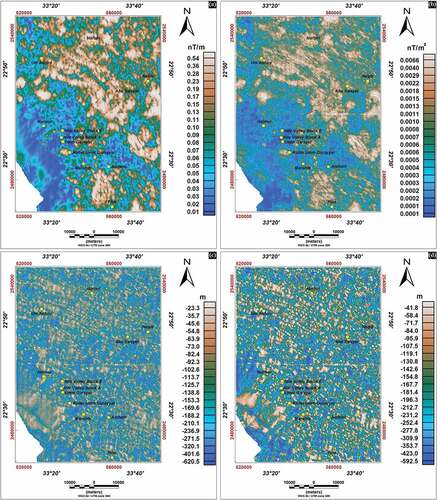
Figure 11. (a) 3D gridding, (b) 3D symbol simulation, of the depths to magnetic sources/contacts estimated using the SPI technique which suggests a ductile–brittle transitional/deformational zone (DBZ).
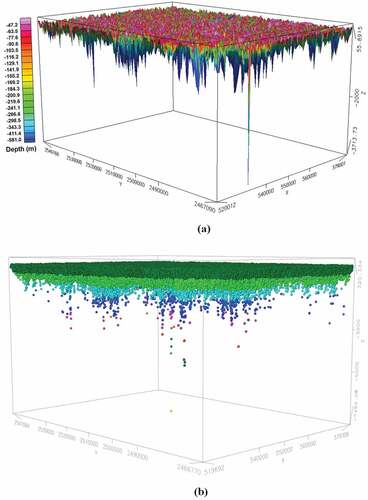
Figure 12. Landsat 8 band composition images over the west AHS. (a) Pan-sharpened natural (true) colour of OLI band composition as Red: B4, Green: B3 and Blue: B2. (b): (g) False colour composite (FCC) images using OLI and TIRS bands, band ratios and PCA images. (Bands included in the FCC composition, in the RGB channels, are labelled over each image).
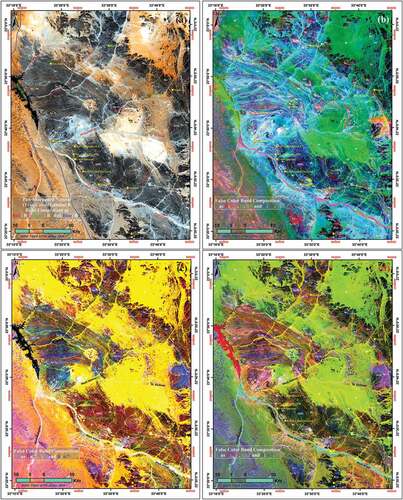
Table 4. Geological maps that were used for correlation and labelling the Landsat 8, TCC and FCC, images over the west Allaqi-Heiani Suture (AHS).
Figure 13. (a) Superimposing image combines hydroxyl-bearing, iron-oxide alterations and fracture system, the highest earlier three lineament density contours, all over a real colour image of Google Earth. (b) Remotely sensed ranking of the prospective mineralisation zones in west AHS, Diagram, c represents a legend of the probable mineralisation categories. (c) The pyramid scheme describes the ranking order of prospective mineralisations according to the existence of alteration zones and the structural control system. The top of the diagram (red colour) represents the highest ranking (first order) of the probable mineralisation occurrences, while the bottom is the expected lowest potential ranking.
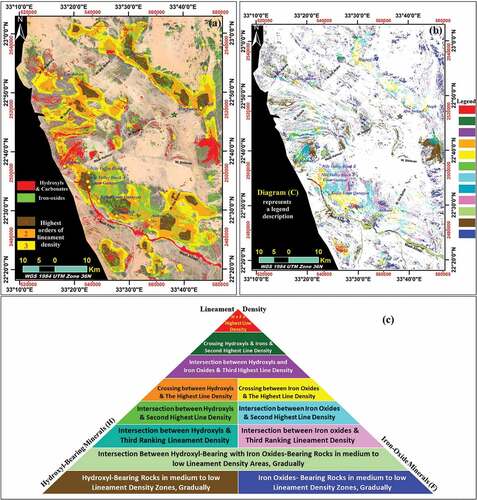
Figure 14. Comparison between the remotely sensed ordering with the known gold mines in west AHS, overlie Google Earth images: (a) Haimur gold mine. (b) Nile Valley Blocks and Um Garayat gold mines. (c) Marahib gold mine. (d) Atshani gold mine. (e) Nagib gold mine and area of Abu Swayel copper mine. (f) Filat gold mine. (g) Um Ashira gold mine. (h) Hariari gold mine. Diagram, c, in , represents a legend of the colours in this figure (Figure 14) and describes the ranking order of the prospective mineralisation occurrences.
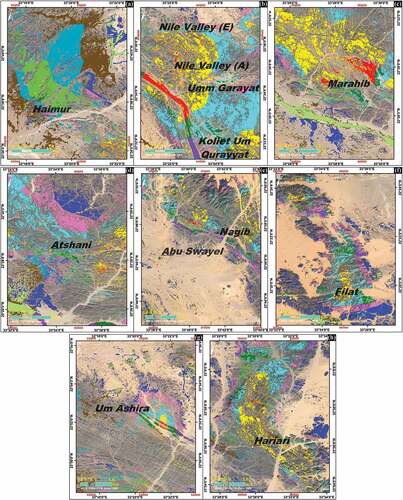
Supplemental Material
Download PDF (12.2 MB)Data availability statement
The data collected for this work are available.

